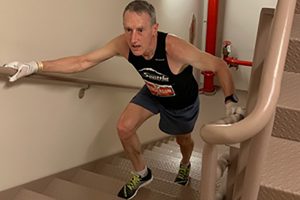Preventing burnout for tech workers
Tech work can strain mental health. But a psychotherapist says there’s a way to prevent burnout.
It’s all about creating your own work-life balance.
Creating your own work-life balance is not what you’d expect to read in a tech employee’s job description.

But it might be one of the most important parts of the gig, according to Sandie Leistiko, a psychotherapist with Pacific Medical Centers who sees many clients who work in the tech industry affected by its pressures.
“Whether gaming or marketing or working for a specific company, we want to give our customers what they want, and they want it now,” she said. “They want it quick and they want it flashy.”
This can lead to some tech workers struggling to find work/life balance, and eventually burning out.
Other jobs, like those in the medical field or banking, for example, have a built-in time-management system. You clock in, you take a break, you clock out. The rest of the day is yours.
“They provide meals, they provide beverages. They provide us with items of comfort, making it really comfortable for us to be there. It doesn’t really seem like there’s a starting and ending point,” Leistiko said.
The ability to work remotely, as provided by many tech companies, can also make some workers feel as though they should work remotely — answering an email or two while away on vacation, for example, doesn’t allow for someone to totally unplug.
These conflicts were documented by a 2015 New York Times exposé where Amazon workers said they had been emailed and texted by coworkers after midnight, for example, or had been seen crying at their desks.
CEO Jeff Bezos later invited workers to email HR or him directly if they experience such treatment in a memo shared with GeekWire. A then-software development manager at Amazon also wrote in a post on LinkedIn: “During my 18 months at Amazon, I’ve never worked a single weekend when I didn’t want to. No one tells me to work nights. No one makes me answer emails at night. No one texts me to ask me why emails aren’t answered.”
And Amazon is hardly the only company to have workers feel this kind of pressure. The increase in workers being plugged in 24/7 has also lead to greater burnout — a 2018 study by Deloitte shows 77% of 1,000 respondents reporting burnout at their current job. Nearly half of millennials surveyed in that study said they left a job specifically because of burnout.
Even sought-after benefits like unlimited vacation come with a bit of an unseen caveat. If you’re never around, you might miss out on getting assigned a major project, for instance.
“People are taking less time off because of that competition,” Leistiko said.
But the way Leistiko sees it, it’s not entirely the company’s fault.
“If (workers) have flexibility with where we work, how much we work, is it in our home or not, then it’s up to that person to create boundaries for themselves,” she said. “No one is the bad guy. It’s up to the worker to determine ‘What do I value? What is good for me? What is good for others?'”
This can be a struggle for some. Perhaps a worker just moved to Seattle for their new tech job. Without a support system here, they might stretch themselves in an effort to be a team player or to fit in.
It’s undeniable that jobs at large tech companies are some of the most coveted and offer unique benefits. Getting hired is likely to be celebrated by a new employee.
So, what steps can they take to make their transition a success?
The two most important steps, Leistiko said, are self-awareness and boundary setting: self-awareness of a person’s values and what makes their life meaningful, and being able to set boundaries in order to create a sustainable lifestyle.
At some point, she added, it might be worth evaluating whether an employee’s values mirror those of their company.
“Because it might not be a good fit,” she said.
How to Set Goals You’ll Actually Accomplish

We all have things we want when it comes to our health: lose weight, be more fit, manage chronic diseases—the list goes on and on. But sometimes, turning that goal into a reality can be tough! We know where we’d like to end up, but getting there seems like an impossible task.
When setting new health goals, most people start off inspired and energized with a solid plan in place; they’re having salad every day, easily ignoring the donuts in the break room and happily going to the gym a couple times per week. But then the excitement starts to dwindle, and they miss a couple workouts. They start to tire of salad and look longingly at their coworker’s General Tso chicken. A new project pops up at work, requiring late nights fueled by tacos and energy drinks. Before they know it, they’re back where they started, upset with their apparent lack of willpower.
Sound familiar? The good news is it doesn’t have to be this way! Focusing on a few key steps can make all the difference.
Discover Your Ultimate Objective
I’ll be honest; eating healthy all the time isn’t always easy, even for a dietitian. Sure, at this point it’s become almost second nature for me, but I still have days when I want to throw in the towel and switch to an all-pizza diet. Eating healthy is important to me, but it’s not enough to keep me motivated all the time. What I rely on during those pizza-dreaming days are my two ultimate objectives: I don’t want to spend money unnecessarily, and I want to feel good. Both are extremely important to me and can get me back in action when my motivation starts to waver.
Being able to identify what’s most important to you gives you a safety net for your goal. For example, when a goal of losing 30 pounds is no longer motivating, you can fall back on your ultimate objective of feeling comfortable no matter what you wear.
Manage Your Expectations
Have you heard the saying it takes 21 days to form a new habit? As encouraging and straightforward as that sounds, the truth is, it can actually take up to 240 days. Still feel like packing your lunch is a chore after a couple weeks? That’s ok! Turning a new behavior into an automatic routine is supposed to take a while. Forming new habits doesn’t follow a linear path of progress; slip-ups and forgetfulness are bound to happen along the way. Give yourself permission to make some mistakes as you go and learn from them.
Consider the Cost
When it comes down to it, setting a health goal is actually the easy part. It’s easy to think about what you could do or what you want to do—who wouldn’t want to run a marathon or get 8 hours of sleep every night? The hard part is determining what you’ll need to sacrifice in order to get what you want. Before setting a goal, spend some time thinking about what you’ll need to give up to actually achieve it. Will it be time with your friends, Netflix bingeing or your coworker’s famous double chocolate brownies? Or will you be embarking on a complete lifestyle change where all your old habits and foods will be left behind?
Once you have a clear idea of what you’ll be giving up, ask yourself: Am I willing to accept this sacrifice? Your answer will give you an indication of the likelihood that you’ll accomplish this particular goal. If the costs are too high, it’s unlikely you’ll experience success. If that’s the case, you may need to hightail it back to the drawing board and come up with a goal that’s more realistic.
Plan for Bumps in the Road
Remember those mistakes and slip-ups that are bound to occur? One way to reduce their frequency and minimize their effect is to identify what could cause them to arise in the first place. Maybe your goal is to go for a walk outside every day, but you really dislike being in the rain. Here in Washington, you know there will be plenty of days when it might not be feasible for you to accomplish your goal. For those instances, it’s helpful to have a back-up plan already in place: find a treadmill with a view or a workout class that keeps you moving. When it comes to setting goals, be realistic about your lifestyle and preferences.
Assemble Your Team
Last but certainly not least is sharing your goal with others—putting it out there in the world is what makes it real. Until you let people in on what you’re up to, the only person you’ll have to be accountable to is yourself. And while that may work for some people, most of us are just terrible at holding ourselves accountable. Be honest with yourself about your limitations and find people who can help fill in the gaps. Ask them to be your cheerleaders, support systems or accountability buddies. Have people you can brainstorm with, or even vent to. Having supportive people around you will give you that extra push when you need it and could even make accomplishing your health goals a more enjoyable experience.
Peach caprese salad
Climbing to new heights
 At age 56, competitive stair climber Mark Henderson is just hitting his stride
At age 56, competitive stair climber Mark Henderson is just hitting his stride
Some people are born to be true competitors; others just want to be fit and healthy for life. Mark Henderson, a PacMed™ patient, happens to be both. Racing up stairs was not Mark’s first choice of physical activity. For many years, the retired Navy commander competed multiple times per week at racquetball and road and trail running. Nagging injuries led him to seek the cause of some pain that rest and recuperation would not heal.
An X-ray revealed Mark had arthritis, both in his back and hip.
“I wish I would have known earlier that it was arthritis,” says Mark. “I blame myself… I would just ignore the pain and think rest would make it better.”
Mark’s arthritis diagnosis led him to Aysha Morgan, a physical therapist at PacMed Canyon Park in Bothell.
“When Mark first came to see me, I could tell he was an incredibly fit yet frustrated individual because he was in so much pain,” recalls Aysha. “He was told he needed a total hip replacement, but we decided together to first try targeted physical therapy for specific muscle groups that would allow Mark to continue to function at a competitive level.”
Their agreed-upon plan worked incredibly well. Today, Mark is the #2 ranked amateur stair climber in the nation—placing second in Seattle’s recent Big Climb, winning the 50+ national championship in Las Vegas two years running and placing ninth among international climbers in the Empire State Building Run Up.
Mark says he worked with Aysha for six months, “primarily to improve my flexibility and strength so I could retain as much mobility in my hip as possible…I kept doing the basic stretching and specific exercises she taught me, along with working in some yoga.”
“Stair climbing is remarkably easy on the joints,” adds Mark. “You’re really not running; you just take a couple of steps and use the handrails to propel you up each flight of stairs.”
What’s Mark’s advice for staying active in spite of a physical challenge?
“Find an exercise or activity that’s right for you, whether it be hiking, stair climbing, tennis or swimming. It’s also a good idea to have a workout buddy. I’ve found a couple of training partners who are as crazy about climbing stairs as I am!
“As far as working through injuries, don’t ever give up. Listen to your body and seek quality medical care if you need it. I’m confident that when I do need to get my hip replaced, PacMed’s access to top orthopedic surgeons in the area will enable me to get back to being as competitive as I can in whatever sport I am able to pursue.”
Ask PacMed about Medicare
Ask PacMed
Patients often ask…“I’m turning 65 next year. What do I need to know about Medicare?”
Medicare is a great program, but it’s different from the commercial insurance you might be used to. You need to apply for Medicare within three months either side of turning 65—or you can’t join until the next enrollment period, and you’ll pay a penalty.
Basic Medicare includes Part A for hospital stays and Part B for outpatient services. Most people get Part A for free and pay a monthly premium for Part B. You can optionally add Part D for prescription drug coverage.
It’s important to remember, Medicare alone won’t cover all your health care costs. Medicare pays only 80% of items it covers, and it doesn’t cover long-term care, eyeglasses, dental care, hearing aids or extra perks.
To cover some of these extras, you have two options to add to Medicare. One is a Medicare supplement known as Medigap, which pays the extra 20%—only for services that Medicare covers. You’ll pay an extra premium for a Medigap policy.
The other option is Medicare Advantage. These plans may cover vision, dental, hearing aids and long-term care, along with other perks like gym memberships, massage or acupuncture. However, you will likely still pay a portion of the extra 20% for covered services with Medicare Advantage. Some of these plans charge a premium and others do not.
You can’t have both Medigap and Medicare Advantage; you have to choose one or the other.
For help with your individual situation, PacMed offers free services, including Medicare information sessions and a hotline where you can ask questions or schedule a consultation. Just call 1.877.315.3279.
Health care decisions are important for your quality of life as you age. Please let us know if we can help.
Submit your question to StayHealthy@pacmed.org, and you may see it answered by a PacMed expert in the next Healthy Today.









